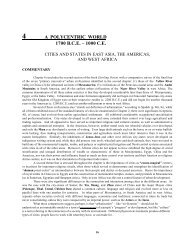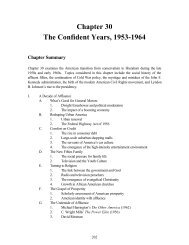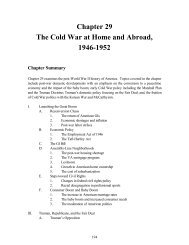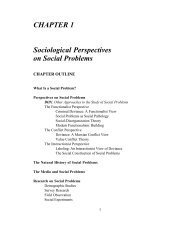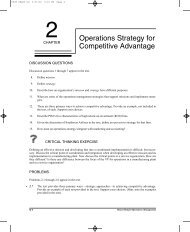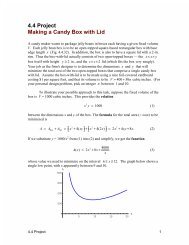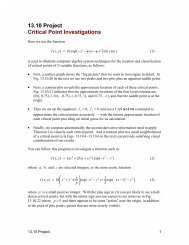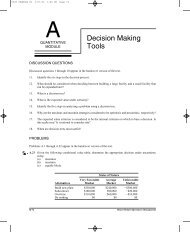Merchandising Operations and the Accounting Cycle - Pearson
Merchandising Operations and the Accounting Cycle - Pearson
Merchandising Operations and the Accounting Cycle - Pearson
You also want an ePaper? Increase the reach of your titles
YUMPU automatically turns print PDFs into web optimized ePapers that Google loves.
Exhibit 5-5. All <strong>the</strong> new accounts—Inventory, Cost of Goods Sold, <strong>and</strong> <strong>the</strong> contra<br />
accounts—are highlighted for emphasis. The additional data item (b) gives <strong>the</strong> ending<br />
inventory figure as $40,200.<br />
Preparing <strong>and</strong> Using <strong>the</strong> Work Sheet of a<br />
<strong>Merch<strong>and</strong>ising</strong> Business<br />
The Exhibit 5-6 work sheet is similar to <strong>the</strong> work sheets we have seen so far, but<br />
<strong>the</strong>re are a few differences. This work sheet does not include adjusted trial balance<br />
columns. In most accounting systems, a single operation combines trial balance<br />
amounts with <strong>the</strong> adjustments <strong>and</strong> extends <strong>the</strong> ad-<br />
justed balances directly to <strong>the</strong> income statement<br />
<strong>and</strong> balance sheet columns. Therefore, to reduce<br />
clutter, <strong>the</strong> adjusted trial balance columns are omitted<br />
so that <strong>the</strong> work sheet contains four pairs of<br />
columns, not five.<br />
Account Title Columns The trial balance lists a<br />
number of accounts without balances. Ordinarily,<br />
<strong>the</strong>se accounts are affected by <strong>the</strong> adjusting process.<br />
Examples include Interest Receivable, Wages<br />
Payable, <strong>and</strong> Amortization Expense. The accounts<br />
are listed in order by account number, <strong>the</strong> order<br />
<strong>the</strong>y appear in <strong>the</strong> ledger. If additional accounts<br />
are needed, <strong>the</strong>y can be written in at <strong>the</strong> bottom of<br />
<strong>the</strong> work sheet above <strong>the</strong> net income amount.<br />
Student to Student<br />
I had problems remembering <strong>the</strong> different journal<br />
entries to use in <strong>the</strong> work sheet. I found that Exhibit<br />
5-2 on page 225 was very helpful in remembering<br />
<strong>the</strong> journal entries for purchases <strong>and</strong> merch<strong>and</strong>ise<br />
sales. If I remember one account in <strong>the</strong> entry, <strong>the</strong><br />
operating cycle makes it obvious which o<strong>the</strong>r<br />
account to use.<br />
Cam M., Abbotsford<br />
Trial Balance Columns Examine <strong>the</strong> Inventory account in <strong>the</strong> Trial Balance.<br />
Inventory has a balance of $40,500 before <strong>the</strong> physical count at <strong>the</strong> end of <strong>the</strong> year.<br />
Cost of Goods Sold’s balance is $90,500 before any adjustment based on <strong>the</strong> physical<br />
count. We shall assume that any difference between <strong>the</strong> Inventory amount on<br />
<strong>the</strong> trial balance ($40,500) <strong>and</strong> <strong>the</strong> correct amount based on <strong>the</strong> physical count<br />
($40,200) is unexplained <strong>and</strong> should be debited or credited directly to Cost of Goods<br />
Sold.<br />
Adjustments Columns The adjustments are similar to those discussed in Chapters<br />
3 <strong>and</strong> 4. They may be entered in any order desired. The debit amount of each entry<br />
should equal <strong>the</strong> credit amount, <strong>and</strong> total debits should equal total credits. You<br />
should review <strong>the</strong> adjusting data in Exhibit 5-5 to reassure yourself that <strong>the</strong> adjustments<br />
are correct.<br />
Income Statement Columns The income statement columns contain adjusted<br />
amounts for <strong>the</strong> revenues <strong>and</strong> expenses. Sales Revenue, for example, has an adjusted<br />
balance of $169,300.<br />
The income statement column subtotals indicate whe<strong>the</strong>r <strong>the</strong> business had a net income<br />
or a net loss.<br />
• Net income: Total credits > Total debits<br />
•Net loss: Total debits > Total credits<br />
Austin Sound’s total credits of $170,300 exceed <strong>the</strong> total debits of $116,450, so <strong>the</strong><br />
company earned a net income.<br />
Insert <strong>the</strong> net income amount in <strong>the</strong> debit column to bring total debits into agreement<br />
with total credits. Insert a net loss amount in <strong>the</strong> credit column to equalize<br />
total debits <strong>and</strong> total credits. Net income or net loss is <strong>the</strong>n extended to <strong>the</strong> opposite<br />
column of <strong>the</strong> balance sheet, so that total debits equal total credits.<br />
Balance Sheet Columns The only new item on <strong>the</strong> balance sheet is Inventory.<br />
The balance listed in Exhibit 5-6 is <strong>the</strong> ending amount of $40,200, as determined<br />
by <strong>the</strong> physical count of goods on h<strong>and</strong> at <strong>the</strong> end of <strong>the</strong> period.<br />
KEY POINT<br />
If you were preparing a work<br />
sheet, you could omit <strong>the</strong> adjusted<br />
trial balance columns. Once you<br />
underst<strong>and</strong> <strong>the</strong> mechanics of <strong>the</strong><br />
work sheet, you can take a trial<br />
balance amount, add or subtract<br />
<strong>the</strong> adjustments, <strong>and</strong> extend <strong>the</strong><br />
new amount to ei<strong>the</strong>r <strong>the</strong> income<br />
statement or balance sheet<br />
columns.<br />
Chapter Five <strong>Merch<strong>and</strong>ising</strong> <strong>Operations</strong> <strong>and</strong> <strong>the</strong> <strong>Accounting</strong> <strong>Cycle</strong> 239



